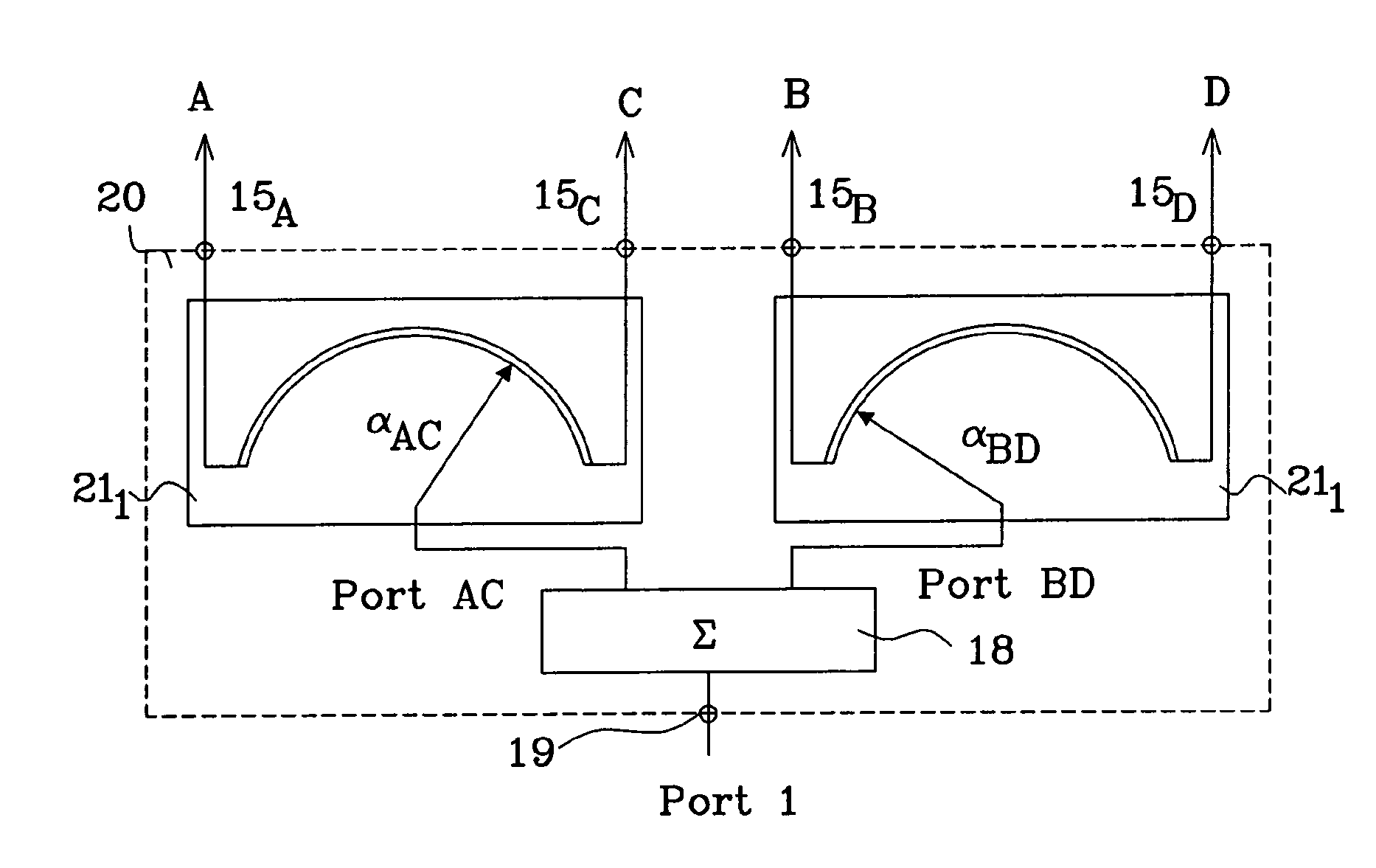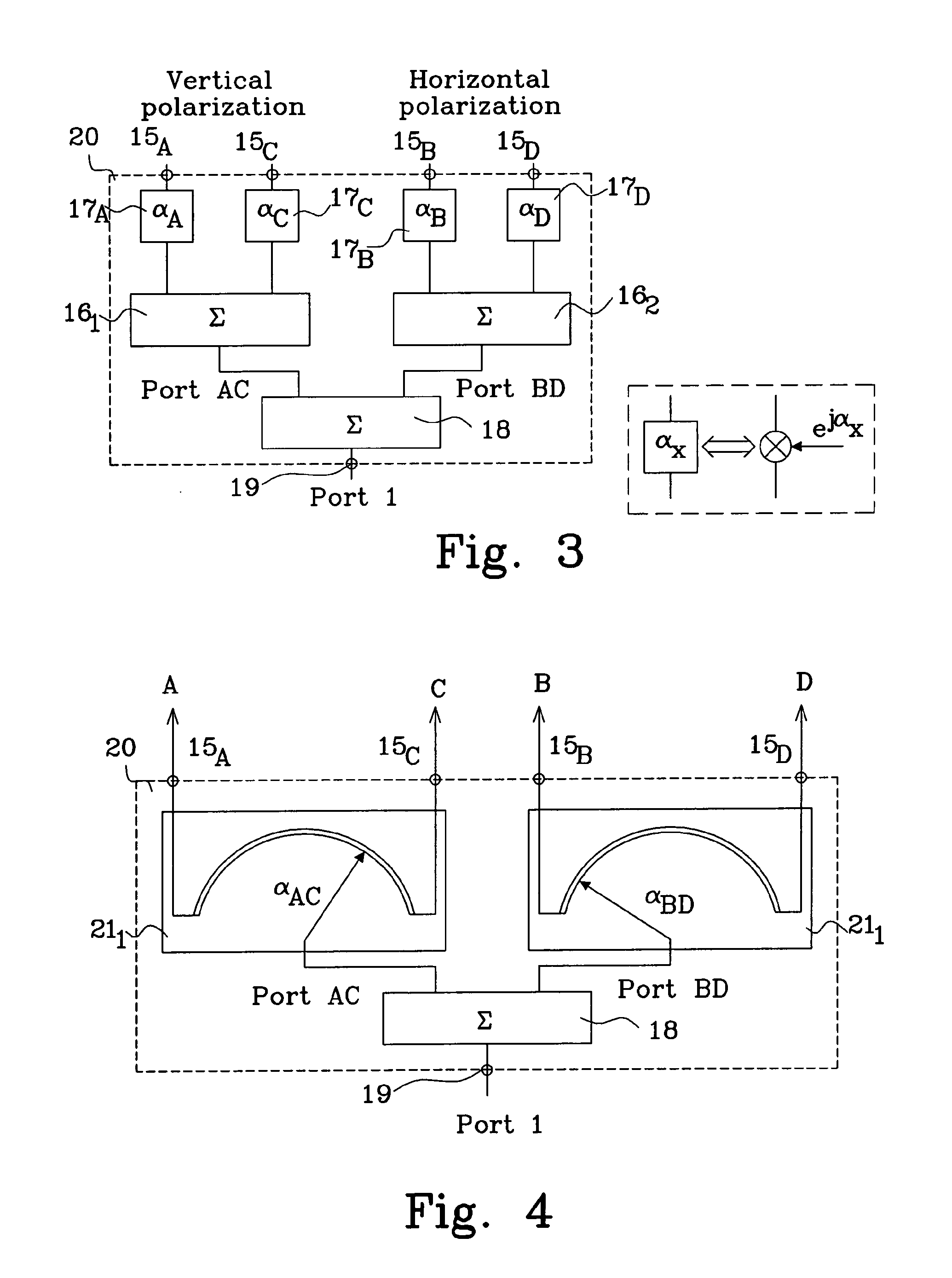Antenna with adjustable beam characteristics
a beam characteristic and adjustable technology, applied in the direction of antennas, differentially interacting antenna combinations, antenna details, etc., can solve the problem of relative complexity of mechanical designs, and achieve the effect of simple design and flexible design
- Summary
- Abstract
- Description
- Claims
- Application Information
AI Technical Summary
Benefits of technology
Problems solved by technology
Method used
Image
Examples
example 1
[0059]As an example, a first single beam antenna as described in connection with FIGS. 1-4, is simulated in which the number of array elements in each column is 12 (i.e. N=12) and the column separation DH between array elements, and thus the distance between first and second phase centres arranged in different columns, is selected to be half a wavelength (DH=0.5λ), and assuming a radiating element pattern with a half power beam width of 90°.
[0060]FIG. 5 shows predicted azimuth beam patterns for the first single beam antenna and the variable phases:
αAC=−αBD=α
for different angles α expressed in terms of the spatial beam pointing angle φ(α). Curve (0;0) denotes φ(αAC)=φ(αBD)=0, curve (17;−17) denotes φ(αAC)=−φ(αBD)=17, curve (23;−23) denotes φ(αAC)=−φ(αBD)=23, curve (27;−27) denotes φ(αAC)=−φ(αBD)=27, and curve (30;−30) denotes φ(αAC)=−φ(αBD)=30. For the azimuth beam patterns the half power beam width is 50, 56, 65, 77 and 90 degrees, respectively.
[0061]FIG. 6 shows the corresponding e...
example 2
[0064]As a further example, a second single beam antenna as described in connection with FIGS. 1-4, in which the number of array elements in each column is 12 (i.e. N=12) and the column separation DH between array elements, and thus the distance between first and second phase centres arranged in different columns, is selected to be seven tenths of a wavelength (DH=0.7λ), and assuming a radiating element pattern with a half power beam width of 65°.
[0065]FIG. 9 shows predicted azimuth beam patterns for the second single beam antenna and the variable phases:
αAC=−αBD=α
for different angles α expressed in terms of the spatial beam pointing angle φ(α). Curve (0;0) denotes φ(αAC)=φ(αBD)=0, curve (13;−13) denotes φ(αAC)=−φ(αBD)=13, curve (19;−19) denotes φ(αAC)=−φ(αBD)=19, curve (22;−22) denotes φ(αAC)=−φ(αBD)=22, and curve (23;−23) denotes φ(αAC)=−φ(αBD)=23. For the azimuth beam patterns the half power band width is 35, 41, 55, 71, and 83 degrees, respectively.
[0066]FIG. 10 shows predicted ...
example 3
[0074]As an example, a first dual beam antenna as described in connection with FIGS. 11-13, in which the number of array elements in each column is 12 (i.e. M=6) and the column separation DH between array elements, and thus the distance between first and second phase centres arranged in different columns, is selected to be half of a wavelength (DH=0.5λ), and assuming a radiating element pattern with a half power beam width of 90°.
[0075]FIG. 14 shows predicted azimuth beam patterns for the first dual beam antenna and variable phases:
αA−αG=αF−αD=αB−αH=αE−αC=α
for different angles α expressed in terms of the spatial beam pointing angle φ(α). Curve 1 (0;0) and curve 2 (0;0), which denotes φ=0 for each antenna port, overlap and similarly curve 1 (17;−17) and curve 2 (−17;17), curve 1 (23,−23) and curve 2 (−23;23), curve 1 (27;−27) and curve 2 (−27;27), and curve 1 (30;−30) and curve 2 (−30;30) are pair-wise identical, i.e., the radiation patterns associated with antenna ports 1 and 2 over...
PUM
 Login to View More
Login to View More Abstract
Description
Claims
Application Information
 Login to View More
Login to View More - R&D
- Intellectual Property
- Life Sciences
- Materials
- Tech Scout
- Unparalleled Data Quality
- Higher Quality Content
- 60% Fewer Hallucinations
Browse by: Latest US Patents, China's latest patents, Technical Efficacy Thesaurus, Application Domain, Technology Topic, Popular Technical Reports.
© 2025 PatSnap. All rights reserved.Legal|Privacy policy|Modern Slavery Act Transparency Statement|Sitemap|About US| Contact US: help@patsnap.com



